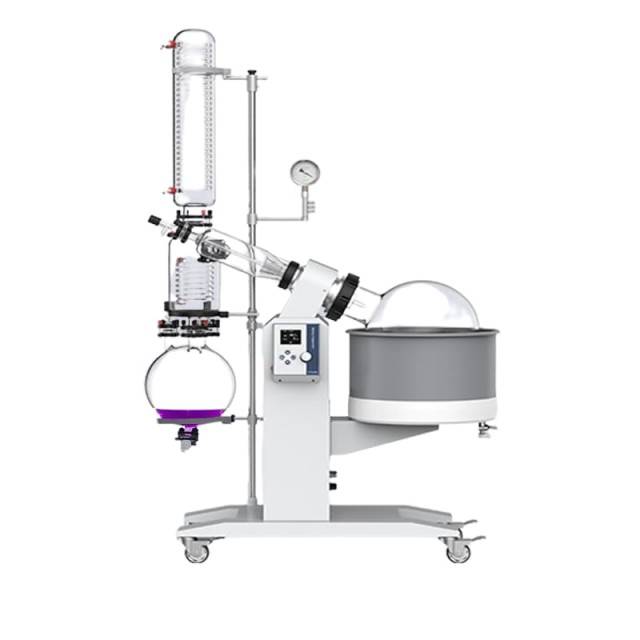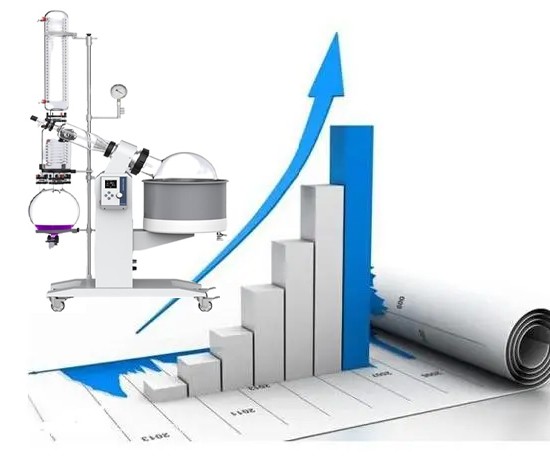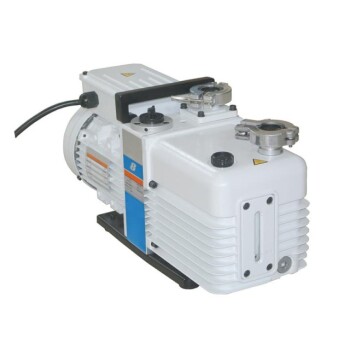Introduction on the Benefits of Rotary Evaporation
Rotary evaporation is a technique used to remove solvents from samples, typically with the use of a vacuum. This method is widely used in laboratories due to its efficiency, safety, and cost-effectiveness. One of the main benefits of rotary evaporation is its ability to concentrate samples, making it easier to analyze and study. Another advantage is the ability to recover expensive or sensitive solvents, which can save time and money. Additionally, rotary evaporation is a gentle process that does not expose samples to high temperatures or harsh conditions, preserving their integrity and purity. Overall, rotary evaporation is an essential tool for any laboratory looking to increase efficiency and productivity in sample preparation.
Table of Contents
- Introduction on the Benefits of Rotary Evaporation
- Factors that Speed up Evaporation
- How Decreased Pressure Affects Evaporation Rate
- Increased Temperature and Its Impact on Evaporation
- The Importance of Flask Rotation
- The Advantages of Using a Rotary Evaporator
- A Comparison of Rotary Evaporation and Standard Distillation
- Can a Rotary Evaporator Remove Water?
- Conclusion on the Efficiency of Rotary Evaporation
Factors that Speed up Evaporation
Evaporation is a crucial process in chemical laboratories. It is essential to speed up the process of evaporation to increase the productivity and efficiency of the laboratory. Here are the factors that can help speed up the process of evaporation:
Decreased Pressure within the System
The presence of a vacuum decreases the pressure within the system. This decreases the vapor pressure required for boiling to occur, thus lowering the boiling point of the solvent. This means less heat energy is needed for it to evaporate. A lower pressure can speed up the rate of evaporation, as the molecules can enter the atmosphere at a faster rate.
Increased Temperature of the Solvent
An increase in temperature will increase the vapor pressure, leading to evaporation. However, whether you’re using increased temperature in a rotary evaporation or standard distillation setup, it takes time and energy to heat a bath. This reduces the efficiency of using increased temperature to evaporate the solvent.
Rotation of the Flask
The rotation of the flask plays an important role in a rotary evaporation setup for two major reasons: increased surface area of the solvent and agitation of the water bath liquid. Rotation of the flask agitates the water bath liquid, allowing for improved heat transfer to the flask and solvent. Additionally, rotation increases the surface area of the liquid inside the flask, increasing the evaporation rate.
While faster is generally better, there’s a point at which a faster speed can actually lower the efficiency of evaporation. It has been shown that, at a certain speed, the turbulence of the liquid is lowered as the sample becomes pressed against the sides of the flask. In general, a speed of 250–280 rpm is recommended for maximum turbulence in benchtop-scale rotary evaporators.
Cooling System
The distillation efficiency is better if the temperature of the cooling system is kept at a temperature difference of 40 °C from the temperature of the heating pot. This allows for the formed hot steam to be rapidly condensed to reduce the influence of steam on the vacuum degree of the system. A commonly used cooling medium is circulating condensate. If there is a substance with a particularly low boiling point, an ice water bath and an ice ethanol bath using a circulating refrigerator as a carrier are also common choices.
In conclusion, the above-listed factors play a significant role in speeding up the process of evaporation. A rotary evaporator is an essential laboratory equipment that uses these factors to boost the efficiency and productivity of the laboratory. By using a combination of these factors, you can achieve faster and more efficient evaporation, thus saving time and resources in your laboratory.

How Decreased Pressure Affects Evaporation Rate
If you work with liquid samples in a laboratory, you may have encountered traditional methods of evaporation, which can be time-consuming and inefficient. A rotary evaporator, on the other hand, offers a more efficient and faster way of evaporation. The device applies decreased pressure to the sample, which lowers the boiling point of the liquid and increases the rate of evaporation.
The Science Behind Decreased Pressure and Evaporation Rate
When you apply decreased pressure to a liquid sample, you lower its boiling point. For example, water boils at 100°C at atmospheric pressure, but at 20°C under a pressure of 2.5 kPa. The lower the pressure, the lower the boiling point of the liquid. In a rotary evaporator, the vacuum pump applies decreased pressure to the sample, which lowers the boiling point of the liquid and speeds up the evaporation process.
The Advantages of Decreased Pressure
Decreased pressure allows for more precise control over the process, enabling you to adjust the temperature, pressure, and rotation speed to optimize the evaporation process. This technology is widely used in laboratories for various applications, such as solvent removal, concentration, and purification of organic compounds.
Precise Control Over the Process
By applying decreased pressure, you can achieve a high evaporation rate without overheating or damaging the sample. The pressure is controlled through a vacuum pump, which can be adjusted to the specific needs of the sample. This means that you can achieve a high degree of precision and control over the evaporation process.
Faster and More Efficient Evaporation
Using a rotary evaporator with decreased pressure results in faster and more efficient evaporation. This is because the lower boiling point of the liquid reduces the amount of heat required to evaporate the solvent. Additionally, the device allows for more precise control over the process, which means that the evaporation rate can be maximized without overheating the sample.
Reduced Labor Time
Using a rotary evaporator with decreased pressure also reduces labor time. Traditional methods of evaporation require constant monitoring and adjustment, but a rotary evaporator can be programmed to perform the evaporation process automatically.
In conclusion, the decreased pressure applied by a rotary evaporator is a crucial factor that affects the evaporation rate. This technology offers faster, more efficient, and precise evaporation, which can significantly improve the productivity of laboratories dealing with liquid samples.
Increased Temperature and Its Impact on Evaporation

A rotary evaporator is a laboratory equipment designed to remove solvents efficiently from a sample mixture through the process of evaporation. One of the primary ways a rotary evaporator is able to boost efficiency is through its ability to increase the temperature of the sample being evaporated.
The Benefits of Increased Temperature
By increasing the temperature of the sample being evaporated, the solvent molecules within the sample are able to become more volatile, meaning they are more likely to evaporate. Additionally, the increased temperature can also help to speed up the evaporation process, allowing for a much shorter overall evaporation time. This results in an efficient and accurate evaporation process, making a rotary evaporator an essential piece of laboratory equipment.
The Negative Impact of Increased Temperature
However, it is important to note that while increased temperature can be beneficial in some cases, it can also have negative impacts on the sample being evaporated. If the temperature is too high, it can cause the sample to break down or degrade, leading to inaccurate results. Therefore, it is important to carefully monitor the temperature throughout the evaporation process to ensure that it remains within the appropriate range.
Temperature Control
To ensure that the temperature remains within the appropriate range, a rotary evaporator is electronically controlled so that the rotation of the flask can be kept at a constant speed, and the mixture can form a film on the inner surface of the flask, creating a larger surface for heating. All of these factors contribute to the faster evaporation speed of solvent, which means higher efficiency and better accuracy.
Comparison to Traditional Distillation
Both standard distillation and rotary evaporation setups use increased temperature, so this factor does not necessarily make rotary evaporation more efficient than standard distillation. The key is in the rotation. In a static setup, as is seen in standard distillation, the surface area of the solvent is limited. In a rotating flask, the solvent forms a thin film around the sides of the flask, greatly increasing the surface area and speeding up evaporation.
In conclusion, increased temperature plays a crucial role in a rotary evaporator's ability to remove solvents efficiently from a sample mixture through the process of evaporation. While increased temperature can be beneficial, it is important to carefully monitor the temperature throughout the evaporation process to ensure that it remains within the appropriate range.

The Importance of Flask Rotation
A rotary evaporator is an essential piece of laboratory equipment that is used to remove solvents from a sample. One of the key features of a rotary evaporator is the flask rotation, which plays a crucial role in the efficiency of the process.
How Flask Rotation Works
By rotating the flask, the surface area of the sample is increased, allowing for faster and more efficient evaporation. The centrifugal force generated by the rotation causes the sample to form a thin film on the inner surface of the flask, exposing it to more heat and reducing the time required for evaporation. This is particularly important when dealing with samples that have a high boiling point or are sensitive to heat. Without the flask rotation, the sample would take longer to evaporate or may not evaporate at all.
The Benefits of Flask Rotation
The use of a rotary evaporator can significantly boost the efficiency of the process, allowing researchers to achieve their desired results in a shorter amount of time. In addition, the use of a rotary evaporator can also improve the quality of the sample by reducing the risk of thermal degradation or oxidation.
Factors to Consider
When choosing a rotary evaporator, it is important to consider the rotation speed and vessel size. The rotation speed must be precise to ensure that the sample is rotated at the optimal speed for efficient evaporation. The vessel size should be chosen based on the volume of the mixture to be processed. A larger vessel size will improve the heat transfer and evaporation rate of the solvent, while also preventing spillage.
Conclusion
In summary, the importance of flask rotation in a rotary evaporator cannot be overstated. It plays a crucial role in the efficiency and effectiveness of the process, allowing researchers to process samples faster and with greater accuracy. When choosing a rotary evaporator, it is important to consider the rotation speed and vessel size to ensure the best results.
The Advantages of Using a Rotary Evaporator
A rotary evaporator, also known as a rotovap, is a laboratory equipment used in chemical and biological laboratories to separate solvents from samples. The advantages of using a rotary evaporator are numerous.
Efficient Solvent Recovery
The first advantage of using a rotary evaporator is that it allows for efficient solvent recovery, reducing waste and saving valuable resources. The gentle heat and vacuum applied to the solution effectively evaporate the solvent and leave behind a concentrated sample. This makes it possible to recover solvents that would otherwise have been lost.
Precise Temperature Control
The second advantage of a rotary evaporator is that it provides precise temperature control, ensuring that samples are not overheated and damaged. The device uses a water or oil bath to heat the solution evenly, and the temperature can be adjusted to suit the specific requirements of the experiment. This makes it possible to work with heat-sensitive compounds without damaging them.
Versatile and Handles a Wide Range of Sample Sizes
The third advantage of a rotary evaporator is that it can handle a wide range of sample sizes, from small vials to large-scale industrial batches. This makes it possible to use the same device for a variety of applications, reducing the need for multiple machines in the lab. Additionally, the rotary evaporator is versatile and can be used in a variety of applications, including drug discovery, food and beverage analysis, and environmental testing.
Faster and Saves Energy
Another advantage of using a rotary evaporator over traditional distillation apparatus is that evaporation is done at reduced pressure, thus the distillation is performed at a low temperature. This makes it very useful for heat-sensitive compounds. Additionally, the rate of evaporation is fast, and separation can be done in a very short time. This cuts down the wait times and saves energy in the process.
Convenient Controls and Less Risky
The beauty of a rotary evaporator is that it is simple and easier to control. It comes equipped with a set of convenient controls for your use and leverage. You also need not possess huge expertise to be able to have your way in them at all. The equipment is less risky than ordinary rivals and counterparts. It is fitted with tons of safety devices and features that minimize explosions, overheating, short-circuits, and other likely dangers.
Highly Effective
All said and done, the rotary evaporator is highly effective. It does the job of extracting solvents well and with minimal dangers and damages. You can never afford to look elsewhere as this equipment embodies all the traits and strong points that good equipment of this kind is ordinarily expected to. Ultimately, using a rotary evaporator can significantly boost laboratory efficiency, improving productivity, and reducing costs.
A Comparison of Rotary Evaporation and Standard Distillation
Introduction
Distillation is a common process used in laboratories to separate and purify compounds. However, there are different methods of distillation, including rotary evaporation and standard distillation. In this section, we will compare these two methods to understand the advantages of rotary evaporation over standard distillation.

Standard Distillation
Standard distillation involves heating a mixture to its boiling point and collecting the vapor as it condenses. This method works well for separating compounds with significantly different boiling points. However, it can be time-consuming, and there is a risk of thermal degradation and loss of valuable compounds.
Rotary Evaporation
Rotary evaporation is a more efficient method of distillation. It involves using a rotary evaporator to handle larger volumes of solvent and sample, allowing for quicker processing times. The use of a vacuum and gentle heat reduces the risk of thermal degradation and loss of valuable compounds. Additionally, a rotary evaporator allows for continuous distillation, meaning that samples can be continuously added to the system without having to stop and start the process. This can save time and increase productivity.
Precision and Control
A rotary evaporator is a more precise method of distillation, allowing for finer control over temperature and pressure. This can result in higher yields and better purity of the final product. On the other hand, standard distillation lacks precision and control, making it less efficient and effective in separating and purifying compounds.
Conclusion
In conclusion, while standard distillation has been a traditional method of distillation, rotary evaporation offers several advantages that make it a more efficient option. Rotary evaporation has the ability to handle larger volumes, reduces the risk of thermal degradation, allows for continuous distillation, and provides more precision and control over temperature and pressure. As a result, rotary evaporation is a valuable investment for researchers and scientists in the laboratory.
Can a Rotary Evaporator Remove Water?
A rotary evaporator is a powerful tool that can significantly increase efficiency in the laboratory, providing scientists with a more accurate and reliable method of solvent removal. One of the most common questions asked about a rotary evaporator is whether it can remove water. The answer is yes. Here are the steps to follow to remove water using a rotary evaporator:
Determine the composition of the mixture
Before using a rotary evaporator to remove water, you need to determine the percentage of internal ethanol. After several distillations, the composition of the mixture remaining in the flask will be different. You can add more than 5 degrees to the current boiling point of the mixture.
Evaporate the mixture
Change the temperature to speed up the evaporation rate. If the mixture is more complicated, it is not necessary to spend all the time to evaporate the solution. You can obtain the required substances by increasing the temperature. Vacuum with a vacuum pump to further reduce the pressure to lower the boiling point, even if the temperature is not increased, all solutions can be evaporated.
Collect the distilled solvent
An efficient spiral condenser allows us to collect the distilled solvent. Normally, the desired product has a low enough vapor pressure that it will not distill (unless you have the water bath too hot!).
Benefits of using a rotary evaporator for water removal
Rotary evaporators are ideal for removing water, as they can be operated at low temperatures, preventing water from boiling and causing damage to the materials. This equipment can remove water efficiently and effectively, making it a preferred choice for laboratory professionals in various industries.
Conclusion
In conclusion, a rotary evaporator is a powerful tool that can significantly increase efficiency in the laboratory, providing scientists with a more accurate and reliable method of solvent removal. Its ability to remove water and other solvents at low temperatures makes it an indispensable tool for any laboratory dealing with separation and purification processes.
Conclusion on the Efficiency of Rotary Evaporation
In conclusion, rotary evaporation is a highly efficient method of separating and purifying liquids, especially those with high boiling points. By decreasing the pressure, increasing the temperature, and rotating the flask, factors that speed up evaporation, a rotary evaporator can remove solvents quickly, leaving behind a concentrated sample. Compared to standard distillation, rotary evaporation is much faster and requires less solvent. Additionally, a rotary evaporator can remove water, making it an excellent tool for environmental analysis. Overall, a rotary evaporator is a valuable investment for any laboratory looking to increase its efficiency and productivity.
Related Products
- Laboratory Rotary Vane Vacuum Pump for Lab Use
- Evaporation Crucible for Organic Matter
- Evaporation Boat for Organic Matter
Related Articles
- Choosing the Right Rotary Vacuum Evaporator for Your Lab
- Exploring the Science Behind Rotary Evaporators: How They Work and Their Applications
- A Step-by-Step Guide to Using a Rotary Vacuum Evaporator for Solvent Removal
- How to Choose the Best Rotary Evaporator (Rotavapor) for Your Budget
- A Comprehensive Guide to Understanding Rotary Evaporator Chillers



